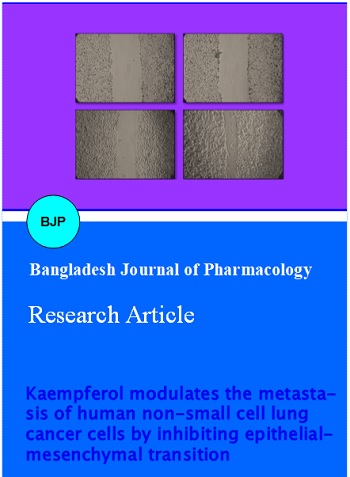Kaempferol modulates the metastasis of human non-small cell lung cancer cells by inhibiting epithelial-mesenchymal transition
DOI:
https://doi.org/10.3329/bjp.v10i2.21739Keywords:
Epithelial-Mesenchymal Transition, Kaempferol, Non-small cell lung cancerAbstract
The present study was done to determine whether kaempferol, a natural polyphenol of the flavonoid family, affects Epithelial-Mesenchymal Transition (EMT) in non-small cell lung cancer cells. Kaempferol not only inhibited cancer cell proliferation and migration in a dose-dependent manner but also modulated the expression of EMT-related proteins E-cadherin and vimentin which are indispensible to cellular motility, invasiveness and metastasis. These results indicate that kaempferol suppresses non-small cell lung cancer migration by modulating the expression of EMT proteins. Therefore, kaempferol may be useful as a potential anticancer agent for non-small cell lung cancer.
Downloads
462
404 Read
182

Published
How to Cite
Issue
Section
License
Authors who publish with this journal agree to the following terms:
- Authors retain copyright and grant the journal right of first publication with the work simultaneously licensed under a Creative Commons Attribution License that allows others to share the work with an acknowledgement of the work's authorship and initial publication in this journal.
- Authors are able to enter into separate, additional contractual arrangements for the non-exclusive distribution of the journal's published version of the work (e.g., post it to an institutional repository or publish it in a book), with an acknowledgement of its initial publication in this journal.
- Authors are permitted and encouraged to post their work online (e.g., in institutional repositories or on their website) prior to and during the submission process, as it can lead to productive exchanges, as well as earlier and greater citation of published work (See The Effect of Open Access).
